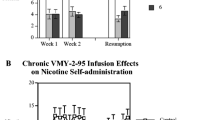Abstract
Nicotine (0.16–0.50 mg/kg, SC) was found to exert a potent antinociceptive action on thermal stimuli as measured by the tail-flick test. This antinociceptive action of nicotine could be blocked by centrally active nicotinic or muscarinic blockers implicating both classes of cholinergic receptors in this effect. Quaternary blockers, however, failed to prevent nicotine-induced antinociception. This finding, together with the ability of small doses of nicotine (25 μg) to induce potent antinociceptive effects when administered centrally, suggests a central site of action for the antinociceptive action of nicotine. The present results also support the suggestion that nicotine may selectively reduce sensitivity to certain classes of pain stimuli, perhaps through a central releasing action on acetylcholine.
Similar content being viewed by others
References
Armitage, A. K., Hall, G. H.: Further evidence relating to the mode of action of nicotine in the central nervous system. Nature 214, 977–979 (1967)
Armitage, A. K., Milton, A. S., Morrison, C. F.: Effects of nicotine and some nicotine-like compounds injected into the cerebral ventricles of the cat. Br. J. Pharmacol. Chemother. 27, 33–45 (1966)
Brodie, B. B., Hogben, A. M.: Some physiochemical factors in drug action. J. Pharm. Pharmacol. 9, 345–380 (1957)
Chen, G.: The anti-tremorine effect of some drugs as determined by Haffner's method of testing analgesia in mice. J. Pharmacol. Exp. Ther. 124, 73–76 (1958)
D'Amour, F. E., Smith, D. L.: A method for determining loss of pain sensation. J. Pharmacol. Exp. Ther. 72, 74–79 (1941)
Davis, L., Pollock, L. J., Stone, T. T.: Visceral pain. Surg. Gynecol. Obstet. 55, 418–426 (1932)
Essman, W. B.: Nicotine-related neurochemical changes: Some implications for motivational mechanisms and differences. In: Smoking behavior: Motives and incentives, W. L. Dunn, ed. Washington: Winston 1973
Flodmark, S., Wramner, T.: The analgesic action of morphine, eserine, and prostigmine studied by a modified Hardy-Wolff-Goodell method. Acta Physiol. Scand. 9, 88–96 (1945)
Friedman, M.: The use of ranks to avoid the assumption of normality implicit in the analysis of variance. J. Am. Statist. Ass. 32, 675–701 (1937)
Goerge, R., Haslett, W. L., Jenden, D. J.: The central action of a metabolic of tremorine. Life Sci 8, 361–373 (1962)
Harris, L. S., Dewey, W. L., Howes, J. F.: The tail-flick test, cholinergic mechanisms. Fed. Proc. 27, 753 (1968)
Ireson, J. D.: A comparison of the antinociceptive actions of cholinomimetic and morphine-like drugs. Br. J. Pharmacol. 40, 92–101 (1970)
Kaakkola, S., Ahtee, L.: Effects of muscarinic cholinergic drugs on morphine-induced catelepsy, antinociception and changes in brain dopamine metabolism. Psychopharmacology 52, 7–15 (1977)
Mattila, M. J., Ahtee, L., Saarnivaara, L.: The analgesic and sedative effects of nicotine in white mice, rabbits and golden hamsters. Ann. Med. exp. Fenn. 46, 78–84 (1968)
Metys, J., Wagner, N., Metysova, J., Herz, A.: Studies on the central antinociceptive action of cholinergic agents. Int. J. Neuropharm. 8, 413–425 (1969)
Morrison, C. F.: The modification by physostigmine of some effects of nicotine on bar-pressing behavior of rats. Br. J. Pharmacol. 32, 28–33 (1968)
Pedigo, N. W., Dewey, W. L., Harris, L. S.: Determination and characterization of the antinociceptive activity of intraventricularly administered acetylcholine in mice. J. Pharmacol. Exp. Ther. 193, 845–852 (1975)
Pert, A.: The cholinergic system and nociception in the primate: Interactions with morphine. Psychopharmacologia 44, 131–137 (1975)
Pert, A., Maxey, G.: Asymmetrical cross-tolerance between morphine and scopolamine induced antinociception in the primate: Differential sites of action. Psychopharmacologia 44, 139–145 (1975)
Phan, D. V., Dòda, M., Bite, A., György, L.: Antinociceptive activity of nicotine. Acta Physiol. Acad. Sci. Hung. 1, 85–93 (1973)
Saxena, P. N.: Mechanism of cholinergic potentiation of morphine analgesia. Indian J. Med. Res. 46, 653–658 (1958)
Slaughter, D., Gross, E. G.: Some new aspects of morphine action. J. Pharmacol Exp. Ther. 63, 34–35 (1938)
Walker, J. M., Sandman, C. A., Berntson, G. G., McGivern, R. F., Coy, D. N., Kastin, A. J.: Endorphin analogs with potent and long-lasting analgesic effects. Pharmacol. Biochem. Behav. 7, 543–548 (1977)
Walsh, J. E.: Applications of some significance tests for the median which are valid under very general conditions. J. Am. Statist. Ass. 44, 342–355 (1949)
Author information
Authors and Affiliations
Rights and permissions
About this article
Cite this article
Sahley, T.L., Berntson, G.G. Antinociceptive effects of central and systemic administrations of nicotine in the rat. Psychopharmacology 65, 279–283 (1979). https://doi.org/10.1007/BF00492216
Received:
Accepted:
Issue Date:
DOI: https://doi.org/10.1007/BF00492216




